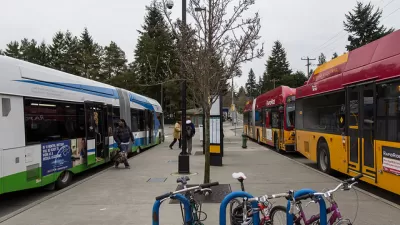The Puget Sound Regional Council (PSRC) released a new "Regional Centers Framework."

"The Puget Sound Regional Council (PSRC) has adopted a new framework for identifying and designating Regional Growth Centers (RGCs) and Manufacturing/Industrial Centers (M/ICs) in the counties of King, Pierce, Snohomish, and Kitsap," reports Stephen Fesler.
"The new framework is an important step as the PSRC moves forward with updating VISION 2040, the regional comprehensive planning policy guide," adds Fessler.
The new framework updates a previous version of the document released in the fall, with some substantial changes regarding mix of uses and transit service. The Framework designates two kinds of Regional Growth Centers: Urban Growth Centers and Metro Growth Centers. "The bar to qualify for Metro Growth Centers is much higher since these are expected to function as very productive areas such as Downtown Seattle and Downtown Bellevue," explains Fessler.
The plan also includes definitions of Manufacturing/Industrial Centers, Countywide Growth Centers, and a few other center types in addition to the Regional Growth Centers. The article includes a lot more detail on the definition of each center type.
FULL STORY: Puget Sound Regional Council Plans to Add New Regional Centers Under Updated Framework

Trump Administration Could Effectively End Housing Voucher Program
Federal officials are eyeing major cuts to the Section 8 program that helps millions of low-income households pay rent.

Planetizen Federal Action Tracker
A weekly monitor of how Trump’s orders and actions are impacting planners and planning in America.

Ken Jennings Launches Transit Web Series
The Jeopardy champ wants you to ride public transit.

Rebuilding Smarter: How LA County Is Guiding Fire-Ravaged Communities Toward Resilience
Los Angeles County is leading a coordinated effort to help fire-impacted communities rebuild with resilience by providing recovery resources, promoting fire-wise design, and aligning reconstruction with broader sustainability and climate goals.

When Borders Blur: Regional Collaboration in Action
As regional challenges outgrow city boundaries, “When Borders Blur” explores how cross-jurisdictional collaboration can drive smarter, more resilient urban planning, sharing real-world lessons from thriving partnerships across North America.

Philadelphia Is Expanding its Network of Roundabouts
Roundabouts are widely shown to decrease traffic speed, reduce congestion, and improve efficiency.
Urban Design for Planners 1: Software Tools
This six-course series explores essential urban design concepts using open source software and equips planners with the tools they need to participate fully in the urban design process.
Planning for Universal Design
Learn the tools for implementing Universal Design in planning regulations.
Ada County Highway District
Clanton & Associates, Inc.
Jessamine County Fiscal Court
Institute for Housing and Urban Development Studies (IHS)
City of Grandview
Harvard GSD Executive Education
Toledo-Lucas County Plan Commissions
Salt Lake City
NYU Wagner Graduate School of Public Service





























